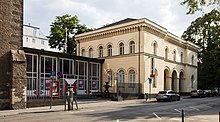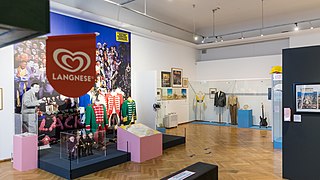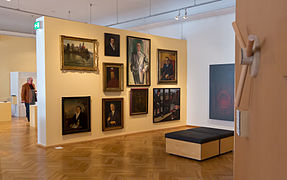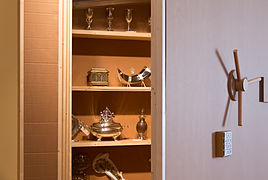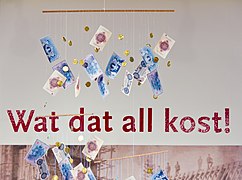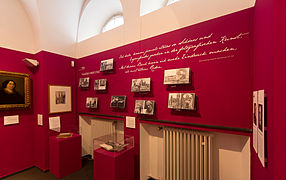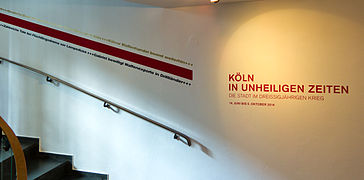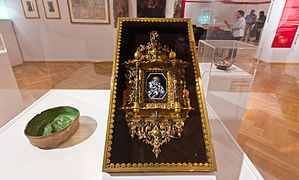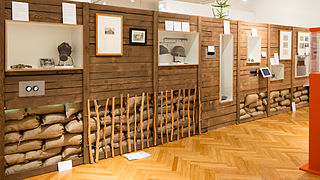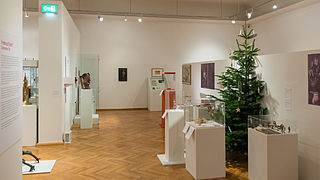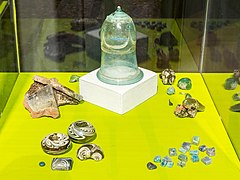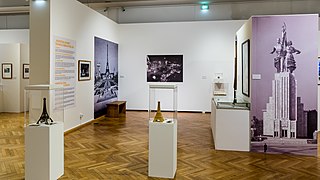Cologne City Museum

The Cologne City Museum is the city history museum of the city of Cologne in the building of the historical armory with the neighboring Prussian old guard .
His collection includes around 350,000 objects from the Middle Ages to the present day . The holdings range from the city seal from 1268 to paintings and graphics, militaria , coins, textiles, furniture and everyday objects to material evidence of current events in Cologne. Social, economic and cultural-historical topics of the last 1200 years can be explored both on the individual object and in thematic depth.
The annual visits in 2018 were over 72,000, whereby - unlike in other cities - half of the audience is registered in Cologne, which has already been interpreted as an indication of Cologne's homeland.
In its more than 130-year history, the city museum resided under changing names and in various buildings in the city area. The current location is also expected to be replaced in favor of a new building in the "historic center" in the area around the cathedral .
The museum has had to do without its permanent exhibition since 2017 because the armory can no longer be used after water damage. Special exhibitions are still regularly presented in the Alte Wache; the move to interim accommodation is in preparation.
history
Beginnings and prehistory
The only universal museum that existed at the end of the 19th century was the Wallraf-Richartz-Museum , founded in 1827 , which was based on the Ferdinand Franz Wallrafs collection - this is considered the oldest museum in Cologne. Even before its foundation, decommissioned weapons and armor as well as all sorts of "antiquities" were presented in a museum. These objects also came to the Wallraf-Richartz-Museum via the Wallraf Collection.
Many even smaller cities founded historical museums at the end of the 19th century due to growing civil society engagement - including Berlin , Munich and already in 1974 Düsseldorf . In times of growing bourgeois historical awareness, it was about the memory of the "old" Cologne, which grew into a modern metropolis during the period of industrialization , and about the documentation and preservation of historical buildings and objects. In parallel to the efforts to create a historical museum, an arts and crafts museum was established , which opened just a few weeks before the new historical museum.
Foundation and first years
When the Hahnentorburg , part of the medieval city fortifications, had been renovated in 1888 as part of the city expansion into Cologne Neustadt , the question of the use of the building arose. One suggestion concerned the storage of the model collection of Cologne Cathedral ; However, the plan of archive director Konstantin Höhlbaum to set up the long overdue historical museum in the Torburg prevailed . In addition, there was the situation that the Wallraf-Richartz-Museum wanted to specialize more in paintings and parts of its collection needed a new place - both arts and crafts and more suitable for the historical museum, such as a coin collection. On July 13th, the city council decided to found a history museum , which then opened on August 14th, 1888.
The director of the new Kunsthistorisches Museum, Arthur Pabst , took over the management - part-time or on a voluntary basis - until his early retirement in 1894. However, the institution was clearly shaped by his successor Joseph Hansen , who also worked as archive director in a double function and so did the Was able to systematically process the collections and their internal connections - documents and manuscripts in the archive, “visual and figurative material” in the museum. The current director Mario Kramp considers his museum concept to be quite modern, as he went beyond a local view of Cologne; he saw research, publication and communication as the task of his institution. Hansen was director until 1924 and managed, for example, in 1902 to acquire the Eigelsteintorburg as a second location. Although this was not considered optimal, it did allow a slightly larger permanent exhibition. Since there was no depot, the substructures of the showcases were used as cupboards for coins and parts of the graphic collection.
Two larger special exhibitions ("Old and New Cöln") took place in 1913 and 1914 in the halls of the Sonderbund exhibition. The historical city model was also created during this period and is still one of the most important exhibits in the permanent exhibition to this day. Hansen's proposal from 1912 to accommodate the holdings in a larger context in the arsenal as a central museum building could not be implemented in the following years, partly because of the World War. By the First World War, however, the historical museum had established itself in such a way that it was able to record around 20,000 visits a year.
Rheinisches Museum in Deutz
At the beginning of 1925, the Historical Museum was given a full-time director for the first time, Wilhelm Ewald . In the same year, the monumental millennium exhibition of the Rhineland in the Deutz exhibition halls attracted 1.3 million visitors. From this, under Mayor Konrad Adenauer, the plan for a Rheinhistorisches or Rheinische Museum arose . This should also be set up on the right bank of the river in the former barracks of the Deutz cuirassiers and take over holdings from the Millennium Exhibition.
The official decision to found the new museum was made on April 1, 1926 by the Cologne city council. Wilhelm Ewald - who was appointed director - presented an "extremely ambitious and for its time progressive museum concept" in the same year. In addition to a permanent collection for the “uprooted […] masses”, the concept emphasized the role of the museum as a scientific and educational institution. In terms of time, Ewald spanned the arc from prehistory to the present, spatially beyond the borders of the Rhine Province , taking into account the diverse relationships with the neighboring regions. Thematically, in addition to historical representations, a comprehensive spectrum including fauna and flora , geology and geography should be covered in eight sections . The concept also included the Rheinische Bildarchiv for a graphic and photographic collection and a Rheinische library. Konrad Adenauer applied to the provincial administration for financial subsidies for the new museum without, however, losing his own influence.
Initially, however, the planned premises were used for the PRESSA exhibition in 1928 , which mainly took place on the neighboring exhibition grounds. For this purpose, the architect Adolf Abel redesigned the building with two classicist, interconnected wing structures. It offered 10,000 m 2 of exhibition space and 4,000 m 2 of storage space.
At the same time, the Historical Museum on the left bank of the Rhine also developed new exhibition concepts for which the spatial program of the two archways was no longer sufficient. By 1930, the collection areas were expanded to include the ecclesiastical and economic development of the city as well as public life and administration. Although Ewald was director of both institutions, he pleaded - unlike others - for their independence, since the Historical Museum is much more concentrated on Cologne than could be possible in a regional museum.
So it was considered, for example, to move the Historical Museum into the rooms of the Wallraf-Richartz-Museum if it were to get a new building. A concept called for by Adenauer for the reorganization of all collections, taking into account the Rheinisches Museum, dragged on - apparently also because of the conflict of competence between the directors. After all, the funds earmarked for the expansion of the two museums had to be saved due to the global economic crisis .
In the meantime, a considerable part of the collection of the Historical Museum had been taken over to the Deutz rooms due to the lack of space, as had large parts of the staff. It was soon only a small step before the two museums were united; in the Eigelsteintorburg only the small independent department "Cologne as Prussian garrison and fortress" remained. Incidentally, the Rheinisches Museum, which also took holdings from other municipal buildings, was never officially opened. The actual historical museum - initially with its own budget and staff - was eventually "absorbed" or "sunk" into it by the Rheinisches Museum (depending on how it was read).
"House of the Rhenish Homeland" during the Nazi era
Despite taking over a wide variety of collections, the rooms of the Rheinisches Museum were never fully furnished. From 1933, however, parts of the exhibition and several special exhibitions could be made accessible to the public. The museum now united in Deutz kept its director Ewald after the " seizure of power " by the National Socialists. Shortly before the opening, it was given the new name "House of the Rhenish Homeland" and was inaugurated on May 21, 1936 in the presence of Gauleiter Josef Grohé and Joseph Goebbels (at the same time as the Cologne-Düsseldorf section of the Reichsautobahn ).
Developments since the year 800 in the Rhineland were illuminated in five large departments and around 150 rooms on an area of 6000 square meters. The prehistory and early history, natural spatial fundamentals and, in the church department, the presentation of Judaism with its “extraordinary” collection of Judaica had to be dispensed with .
The basic Ewald museum concept fit into the National Socialist, völkisch propaganda strategy, whereby after years of pressure from Mayor Adenauer it finally received "unexpected support" from the new rulers - after he had been dismissed from his office in March 1933. The Political Department planned by Ewald in 1933 could not be realized by the time it opened; he initially limited himself to the representation of the National Socialist movement in the Rhineland, which corresponded to the National Socialist minimum requirement for a local museum. However, this was also not complete until the opening. In the years that followed, the exhibition became increasingly political and museum politics more opportunistic, which was reflected in propaganda exhibitions such as “The defensive Germany” (1936), “Volksgemeinschaft - Wehrgemeinschaft” (1937). However, these special exhibitions were only partially curated by the museum itself; for the most part, the museum only provided the rooms for exhibition organizers from various organizations.
Beatrix Alexander from the Cologne City Museum pointed out in 1992 that the presentation of modern history from 1848 until the occupation of the Rhineland followed the National Socialist historical perspective in the permanent exhibition . Apparently, both the number of visits and the planned publication activity after the opening of the museum fell far short of the goals and expectations in the following years.
In 1937, at the suggestion of Georges-Henri Rivière , a leading French museologist, the “House of the Rhenish Homeland” was selected as one of three institutions at the 1937 Paris World Exhibition to represent the German museum industry . Ewald had been in contact with him for years. A diorama on the political and social development of the Rhine Province was awarded a gold medal for exemplary conception and didactics.
With the beginning of the Second World War , individual, particularly valuable pieces were gradually removed without significantly affecting the overall exhibition. From 1942 the city museums closed their permanent exhibitions, the "House of the Rhenish Homeland" was the last to be open. One of the last special exhibitions before the war-related closure showed works by the sculptor Arno Breker in 1943 . At that time the building had already suffered damage from Allied air raids.
Nevertheless, by the end of the war, almost the entire moveable inventory of the museum had been relocated, much of it in the Franconian Graeflich Schönborn'schen Schloss Gaibach , to whose owners Wilhelm Ewald had been in contact for a long time. He, his family and the employees of the museum with their families lived there for long periods of time, so that inventory and restoration work was also carried out in the palace. Edith Meyer-Wurmbach was a long-time employee who looked after the stored stocks for years. Ewald's good network as well as his renewed double role as "responsible commissioner for the entire evacuated property of the city of Cologne" and museum director may well have made use of the museum's holdings in times of war. The majority of the inventory was saved over the war years, but a number of objects were lost through sales or barter campaigns as well as metal levies for armaments purposes. The exact losses can no longer be precisely proven.
A remarkable detail from this chapter of the museum are the unrealized plans for the construction of the monumental National Socialist Gauforum on 300,000 square meters, for which most of Cologne-Deutz should have given way. The "House of the Rhenish Homeland" and the neighboring Schnütgen Museum were not (any longer) included in these plans. In addition, in the context of ongoing discussions on the restructuring of Cologne's museum landscape, there were mind games about its dissolution or division into other houses, which Ewald naturally opposed.
Post-war period - Rheinisches und Historisches Museum
In the immediate post-war years, the first task was to bring the relocated holdings back to Cologne - in part with the support of the US art protection authorities . Wilhelm Ewald was in Gaibach at the end of the war and negotiated with the occupation authorities himself. As the museum buildings were largely destroyed, interim depots were later set up in the city and the surrounding area.
Wilhelm Ewald remained in office as director until 1950 - beyond his retirement limit. He was the only Cologne museum director who did not join the NSDAP and was immediately confirmed in his post in 1945. A historical study of its role over three epochs is still pending; In her dissertation from 2016, the cultural scientist Karin Hieke names indications for a possible system-critical attitude of Ewald; In addition to the fact that he was non-party, she mentioned the fact that he saved the Judaica collection from destruction. Franz Brill , who had worked for many years at the museum , was appointed his successor in 1950 .
The first major historical exhibition in post-war Cologne - "Cologne 1900 Years of the City" - was held from May 26th to August 22nd 1950 in the State House of the Cologne Trade Fair on the occasion of the anniversary of the granting of city rights, the Ius Italicum . It was part of pompous celebrations that staged Cologne's identity under the motto “Cologne is back” (omitting the twelve years from 1933 to 1945). Organized by Wilhelm Ewald and Bruno Kuske , who had also curated the Millennium Exhibition in 1924, the exhibition recorded 250,000 guests, albeit also a deficit of 671,000 DM. On the other hand, this exhibition also delayed the complete return of the relocated holdings to Deutz, which was not completed until 1953 was.
The institution, now known as the Rheinisches und Historisches Museum , opened on June 26, 1953, initially in the renovated 14 rooms on 1000 square meters in Deutz and conceptually focused again primarily on Cologne as the metropolis of the Rhineland.
Cologne City Museum in the armory
Efforts to move the museum back to Cologne on the left bank of the Rhine had been going on since the end of the war. The space provided Armory (built 1594-1606) was down to foundation walls and arches burned and had to - be extensively renovated - after it was taken from federal property in municipal property. This happened until 1956 to such an extent that it was able to accommodate an exhibition on the occasion of the 77th Catholic Day. The intermediate building was completely rebuilt and the adjoining Alte Wache was renovated; however, the latter initially used the Roman-Germanic Museum from 1959 . The opening of the now renamed Cologne City Museum - in terms of exhibition technology as "modern [...] as it was museum and financially justifiable" - was celebrated on January 11, 1958. In addition to its own holdings, it also housed the Rheinische Bildarchiv until 1981 .
Franz Brill, who retired in 1965, did not give the new location a great future because it did not meet the spatial requirements. In addition, the arsenal had to be cleared for the first time in 1963/64 for the major exhibition Monumenta Judaica .
On the other hand, the premises of the Alte Wache could be used as a special exhibition area towards the mid-1970s after the Roman-Germanic Museum had moved into its new building. Branch offices were set up in 1971 and 1981 with the Prussian Optical Telegraph in Flittard (until 2005) and the Zündorf fortified tower . The new director from 1966 was Günther Albrecht , on whose initiative the “Friends of the Cologne City Museum” was founded in 1968. After Albrecht's death in 1974, Hugo Borger took over the management of the Cologne museums on an interim basis, and from 1976 the archaeologist Heiko Steuer .
Another closure took place in 1980 for the Tutankhamun exhibition , after which the permanent exhibition was closed for renovations and a new concept for almost five years. Conceptual modernizations had been going on since the 1970s; however, the renovation after the Tutankhamun exhibition dragged on, whereby the situation was exacerbated by a roof truss fire (which went smoothly) in 1983. Approved funds of 7 million DM were cut to 1 million, and there was still no air conditioning. Other necessary expansions - such as the expansion of the depot area on a farm in Bocklemünd - also got stuck in the planning phase.
It was not until 1984 that museum operations in the armory were resumed, albeit still in a confined space, which required conceptual compromises. Werner Schäfke took over as director for the next 25 years . The museum concept developed by him and his predecessor (backward chronological entry, themed islands) corresponded to the current standards of that time. It was expanded and supplemented selectively in the following decades, around the early 1980s around the Nazi era , but never fundamentally reorganized. The focus was on communication work, museum education and a new staging of the historical city model.

In 1991, the installation of the "Golden Bird" (colloquially: winged car) by the artist HA Schult on the roof of the armory tower caused a stir .
In the Schäfke era, there were also large special exhibitions, which at that time could still take place in the Josef Haubrich Kunsthalle on Neumarkt . The exhibition The Crack in the Sky - Clemens August and his epoch was presented in 2000 in Augustusburg Castle in Brühl . Schäfke published large inventory catalogs and worked together with the NS Documentation Center in 1999 on the much-discussed topic of Wehrmacht crimes because of the Wehrmacht exhibition .
21st Century and Outlook
A visible "rejuvenation" was achieved from 2007 onwards through the renewal of the security concept and increased cooperation with the University of Cologne : security, information and service were largely given into the hands of students of history and art history, who were also given content-wise - for example with guided tours - contribute to museum work.
In order to end the spatial confinement and the meanwhile desolate conditions in technology and building fabric, work began in 2003 on a concept for a renovation and an extension to be built on a neighboring property that was swapped with the state of North Rhine-Westphalia. A pair of donors, who were won over by Deputy Director Michael Euler-Schmidt in 2003/2004 , wanted to contribute 5.5 million euros and have a significant influence on the architecture. However, the conflict between procurement law requirements and the wishes of the donor couple could not be resolved in the end, so that the offer was withdrawn in 2009 The plans were not completely abandoned by the new director Mario Kramp , who took office in 2010 ; In 2011, he presented a feasibility and concept study, which was also based on an extension. Two years later there was still a competition for the renovation and extension.
However, these plans were rejected in favor of a completely new concept that Mayor Jürgen Roters presented in March 2014: After the planned demolition of the Kurienhaus on Roncalliplatz - an exposed location on the south side of Cologne Cathedral - a new building complex is to be built here in cooperation with the cathedral chapter , which houses the Cologne City Museum, together with the cathedral building archive, workshops and administration of the cathedral chapter. At the same time as the renovation of the neighboring Roman-Germanic Museum , whose administrative rooms are also to be expanded, a new "historical center" with three institutions is to be created in the immediate city center. In an architecture competition advertised across Europe, the design by the Berlin architectural office of Volker Staab won first prize in 2016. The planning continues with a revised draft. In order to act together as project sponsors, the city and the Hohe Domkirche founded a company in April 2020. A building decision is still pending (as of July 2020).
In the meantime, the desolate situation of the museum escalated when the permanent exhibition on both floors had to be completely closed since June 2017 due to water damage on the upper floor. The - undamaged - exhibits were relocated. Since then, however, a number of special exhibitions have been held in the Alte Wache .
The former Franz Sauer department store in the city center was initially rented for ten years as interim accommodation. The date of the opening of the interim quarter has not yet been determined (as of July 2020).
Collection holdings

The initial furnishing of the Historical Museum in the Hahnentorburg from 1888 initially consisted of the armory collection that had been preserved after the French occupation, mainly old weapons and armor, scales and weights. Various "antiquities" and objects such as seal stamps were added from the council tower and the city library . Important objects were taken over from the city archives , including the estate of the archbishopric keeper Hermann von Goch (executed in 1398) and probably the oldest red flag in Germany from the revolution of 1848 . Donations and purchases expanded the portfolio in the following years. The foundation for the graphic collection was laid by the estate of Johann Jakob Merlo , which was expanded in the following years to include around a thousand city and Rhineland views. The stock of coins was significantly increased by purchasing from the collection of the Frankfurt numismatist Paul Joseph and others as well as by taking over archaeological finds from Cologne. In addition to these objects, efforts were made to set up a historical kitchen by purchasing appropriate equipment and a department for the Cologne Carnival was set up .
After the Millennium Exhibition in 1925, which presented numerous objects from the Historical Museum, a large part of these was transferred to the new Rhenish Museum in Deutz, with which it was finally merged. Modern exhibition technology such as "instructive models, casts [and] statistics" were included. Due to the concept of the new museum, which has been extended to the Rhineland, objects from rural and middle-class living culture from the Lower Rhine to the Westerwald were added. A collection of Judaica was rebuilt from 1925 , which meanwhile (2013) comprises around 350 objects.
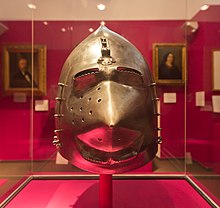
During the time of National Socialism , the house of the Rheinische Heimat was supposed to be a "German folk museum in the best sense" and of "national political importance". It showed the Rhenish history from the Carolingians to the 20th century. A series of Nazi literature was added to the museum inventory, including several copies of Mein Kampf (even after 1945) and other objects of various origins , often in exchange with other institutions.
In the immediate post-war period, a small number of new objects came to the inventory through donations or exchanges. Immediately after the currency reform , a copy of the photo book Gesang im Feuerofen with the Cologne rubble photos was acquired by Hermann Claasen . Even before the move to the arsenal, in 1953 - quite controversial and after approval by the culture and finance plan committee - the extensive portfolio of Cologne as it was could be acquired from August Sander for 25,000 DM.

In the following years the graphic collection was expanded with well over a thousand sheets by Roland Anheisser , Theo Blum , Walter Wegener and Carl Determeyer . In addition there were u. a. Painting by Bartholomäus Bruyn the Younger , Cornelius Springer and Carl Hasenpflug .
The first object in the Cologne City Museum relating to the impending Shoah was added to the collection as a gift in 1965: a small Tefillin capsule that was found in the destroyed synagogue on Glockengasse on November 10, 1938 - one day after the Reichspogromnacht . The Nazi period has been included as the focus of the collection since the early 1980s.
Further objects are the historical Cologne council silver , textiles, and since 1985 also more current and contemporary art, such as a painting of the Cologne Cathedral by Andy Warhol . In addition, gaps were filled in the area of everyday history and everyday life, the topic of migration and thus increasingly the present, from whose everyday culture objects are regularly taken over into the collection , approached . Examples of this are a printed kippah from the visit of Pope Benedict XVI. in the Cologne synagogue community in 2005, a German flag from the 2006 World Cup or costumes from the Cologne studios for the television series Lindenstrasse . However, there are also evidence of more serious events from Cologne's recent past: a flag from the election stand where the assassination attempt on Henriette Reker was carried out, the notebook of a refugee from Syria with plans for the reconstruction of his house, and finally a mouth and nose Mask that was worn during the COVID-19 pandemic in Cologne city council.
exhibition
Permanent exhibition
The presentation of the exhibits was not structured chronologically but thematically. For reasons of space, substantial parts of Cologne's city history remained insufficient or entirely untreated. The house has an average of around 70,000 visitors a year.
Loans from other museums are sometimes shown, such as during the Tut Ench Amun exhibition between June 21 and October 19, 1980, with a visitor record of 1.3 million. Exhibitions that were particularly successful with the public were also held outside the house, such as Der Name der Freiheit 1988 in the Kunsthalle, The Cologne Charterhouse around 1500 in 1991 in the former Charterhouse and The Crack in Heaven - Clemens August and his Epoch 2000 in Schloss Brühl .
The Alte Wache , which is connected to the museum by a connecting building, is still used for special exhibitions .
Special exhibitions
- May 5 to September 27, 2020: 50 Johr Bläck Fööss: The anniversary exhibition in the Cologne City Museum
- Impressions from the exhibition "50 Johr Bläck Fööss"
- 2010: From Marlar and the beautiful Marie. 150 years of Cologne Zoo (May 29 to August 29)
- 2010: Cologne 1:58 p.m. Salvaged Treasures from the Historical Archives (October 3 to November 21)
- 2010/2011: The colossal journeyman. Views of Cologne Cathedral until 1842 (December 10, 2010 to March 5, 2011)
- 2011: Made in Cologne - Cologne brands for the world . From June 11 to September 11, 2011 Internationally known Cologne brands and their history.
- 2011/12: The Waidmarkt, all over the place (October 8 to February 18, 2012)
- Down to business honey! Rarities from the depot
From March 17th to June 10th 2012 the Cologne City Museum showed objects from its depot , which covers 3,900 m², for the first time . For the exhibition, the specific atmosphere of a museum depot was partially created, among other things with the help of steel shelves and a safe made of wood and cardboard .
Over 150 exhibits from Cologne's history from the 16th century to the present day were shown. Objects that Casanova , Jan von Werth or Wolfgang Niedecken owned; Figurines and costumes , a Klingelpütz - cell door and a swastika flag , presumably in Cologne Cathedral go. In addition, stories were told about objects: that of a timbered soap box , that of the ten-year-old boy who found a rusted pistol from the First World War in his parents' garden. Or that of the Cologne astronaut Reinhold Ewald from his space glove during the MIR mission in 1997 .
The exhibition was curated by Deputy Director Michael Euler-Schmidt. The Cologne photographer Boris Becker accompanied the exhibition with a specially created edition.
In the future, a special exhibition with objects from the depot is to be shown once a year; they are to be understood as an accompanying and preparatory measure for a new staging of the Cologne City Museum.
Pictures hanging in Petersburg
- June 1 to August 26, 2012: “In the rubble of Cologne”, Raffael Becker . Raffael Becker donated the 26 works shown there to the city museum
- June 23 to September 16, 2012: REVOLUTION! The painter Wilhelm Kleinenbroich on his 200th birthday In a retrospective, the entire spectrum of Kleinenbroich's artistic work is shown for the first time. Carnival decorations from 1835, portraits from museum and private collections, socially critical pictures and the Rose Monday procession of 1872.
- July 7 to September 16, 2012: A colorful dream. Cologne's Romanesque churches in historicism. The magnificent furnishings of the Romanesque churches are shown, most of which were destroyed during the Second World War and which were rebuilt in the 1950s / 60s with bare walls and "cleaned" with decorations from post-medieval epochs, as 19th century art was then partially obsolete was also considered despicable.
- Impressions from the exhibition "A colorful dream"
- Ralf König - The Ursula Project
- October 13, 2012 to February 9, 2013: Eleven thousand virgins . Ralf König : The Ursula Project
- Impressions from the exhibition "The Ursula Project"
The King's desk (left) and the Golden Chamber of St. Ursula
- March 9 to May 26, 2013: A man from Cologne discovers Egypt. Franz Christian Gau's adventurous expedition to the Orient, 1818–1820
- November 24, 2012 to March 17, 2013: Cologne on the high seas. From the cruiser "Cöln" to the frigate "Köln"
- March 9 to May 26, 2013: COLOGNE / NIL. The adventurous expedition to the Orient by Franz Christian Gau from Cologne 1818–1820
- March 9 to May 26, 2013: BORDERLINES. Jasmina Metwaly: video installation 2013
- March 23 to June 10, 2013: ... earthly bread and heavenly food ... (cabinet exhibition for the Eucharistic Congress Cologne)
- June 23 to November 10, 2013: 125 times bought - given - donated
- For the 125th birthday of the museum, 125 exhibits from 125 years were shown in a special exhibition curated by all employees. All materials and eras are taken into account, and the circumstances of the purchase are also discussed. The exhibition is also a walk through the various locations of the museum: from the Hahnentorburg in 1888 to the armory in 2013.
2013: " Dickie " forever!
- July 2 to September 15, 2013: When the world came to Cologne
- October 12, 2013 to February 9, 2014 small KUBUS exhibition: Josef Haubrich (1889–1961). An eventful life
- December 13, 2013 to April 27, 2014: Top and bottom: the Eigelstein . Scene of Cologne History 2 (in cooperation with the Roman-Germanic Museum )
- June 14 to October 5, 2014: Cologne in unholy times. The city in the Thirty Years War
This epoch, in which Europe is in a state of emergency, is the subject of an exhibition in the Cologne City Museum for the first time. The war raged around Cologne, but the city, intent on neutrality, was spared. Trade was carried out in goods essential to the war effort and the Cologne merchants lent money to the warlords. At the same time, "Dat Hillije Coellen" is a Catholic bulwark in troubled times. Monasteries and monasteries are founded in Cologne.
- Impressions from the exhibition "Cologne in Unholy Times"
- November 22nd, 2014 to April 19th, 2015: Cologne 1914 - metropolis in the west
- As part of the LVR joint project “1914 - In the Middle of Europe. The Rhineland and the First World War ”, the exhibition reminds us of the beginning of the armed conflicts and provides insights into life in the large city on the Rhine around 100 years ago. Clothing, electrical devices, children's toys, testimonies to artistic development and personal documents from contemporaries are on display. At the same time, the Museum of Applied Arts Cologne and the Rhenish-Westphalian Economic Archive are devoting themselves to the complex of topics.
- Impressions from the exhibition "Cologne 1914 - Metropolis in the West"
- December 12, 2015 to April 24, 2016: END STATION UBIERRING. 40 The end of the art and design department in Cologne's Südstadt .
- November 21, 2015 to April 24, 2016: Cologne unadorned. Wilhelm Scheiner as a photographer .
- March 11 to June 12, 2016: Small KUBUS exhibition: in cooperation with the German Dust Archive : Under Cologne Roofs - Cologne Dust as Object Art and Photography
- June 4 to September 6, 2016: Big cinema! 120 years of Cologne cinema history
- June 24th to September 25th, 2016: Small cube exhibition Carl Niessen and the Cologne Theater Museum
- December 10, 2016 to May 14, 2017: in the series Schauplatz Kölner Geschichte 3 Above and beyond: The Heumarkt Schauplatz Kölner Geschichte. , in collaboration with the Roman-Germanic Museum .
- Impressions from the exhibition “The Heumarkt. Location of Cologne history. "
- March 24, 2017 to May 11, 2017: Small KUBUS exhibition Bosporus on the Rhine. The Bosporus restaurant in Weidengasse
- July 1, 2017 to November 19, 2017: Konrad the Great. The Adenauer period in Cologne 1917–1933
- Impressions from the exhibition “Konrad the Great. The Adenauer period in Cologne 1917–1933 "
- December 16, 2017 to March 25, 2018: Karin Richert: In the right light
- December 16, 2017 to March 25, 2018: Alaaf anyway! Cologne Rose Monday 1991 + 2017
- Impressions from the exhibition “Alaaf anyway! Cologne Rose Monday 1991 + 2017 "
- May 5, 2018 to August 26, 2018: Boards that mean the world. Playing through 2000 years of Cologne
- October 20, 2018 to March 31, 2019: Cologne 68! Protest. Pop. Provocation.
- May 4 to July 14, 2019: Ronit Porat. Paradiesvogel - Artist meets archive , in cooperation with the International Photo Scene Cologne
- May 4 to July 14, 2019: You are here - Attempts at a photographic location determination, part 1 , in cooperation with the International Photoscene Cologne
- August 24, 2019 to January 26, 2020: Cologne on the Seine. The city of Cologne pavilion at the 1937 Paris World's Fair
- August 24, 2019 to January 26, 2020: Cologne on the Rhine or: From time to time (in cooperation with the Rheinisches Bildarchiv Cologne )
- Impressions from the exhibition “Cologne on the Seine. The pavilion of the city of Cologne at the Paris World Exhibition 1937 "
guides
The museum offers guided tours through its collections in standard German, Kölsch and - in addition to English - in Turkish.
Library
A publicly accessible reference library complements the museum's offering. Around 50,000 media units on the history of Cologne and the history of the Rhineland are available here. Scientific journals and exhibition catalogs as well as general works on cultural, economic and social history are in the inventory. A collection of old prints from the 15th to 19th centuries can be used as source material for various topics upon request. The library catalog has been continuously digitized since 2019.
Directors
- 1888-1894: Arthur Pabst
- 1894–1924: Joseph Hansen
- 1925–1950: Wilhelm Ewald
- 1950–1965: Franz Brill
- 1966–1974: Günther Albrecht
- 1974–1976: Hugo Borger
- 1976–1984: Heiko Steuer
- 1984– July 2009: Werner Schäfke
- 2009–2010: Michael Euler-Schmidt (provisional)
- Since June 2010: Mario Kramp
literature
- Mario Kramp: The Cologne City Museum. Inventory - basic ideas - perspectives. An approximation . In: History in Cologne . tape 57 , no. 1 , December 2010, ISSN 0720-3659 , p. 188–203 , doi : 10.7788 / gik.2010.57.1.188 .
- Werner Schäfke, Marcus Trier (Ed.): Middle Ages in Cologne. A selection from the holdings of the Cologne City Museum , Emons, Cologne 2009, ISBN 978-3-89705-654-1 .
- Klaus Wolf: From functional buildings to memorials. The City of Cologne Armory as perceived by the early modern public . In: Military and Society in the Early Modern Age 13 (2009), pp. 122–142. Online version (PDF; 282 kB)
- Mario Kramp: 125 years of the Cologne City Museum: 125 times bought - given - donated . (Accompanying volume for the anniversary exhibition). Emons, Cologne 2013, ISBN 978-3-95451-236-2 .
- Katrin Hieke: In the field of tension between politics, innovation and tradition: the Rheinisches Museum, Haus der Rheinische Heimat in Cologne 1925-1956 . (Dissertation, University of Tübingen 2016). 1st edition. Metropol-Verlag, Berlin 2018, ISBN 978-3-86331-410-1 .
To individual stocks
- Ingeborg Unger (arrangement) with a contribution by David Gaimster: Kölner Ofenkacheln. The holdings of the Museum of Applied Art and the Cologne City Museum. Locher GmbH, Cologne 1988, ISBN 3-927396-01-X (important material template).
- Rita Wagner: Cologne picture room. The paintings in the holdings of the Cologne City Museum including the Porz Collection and the Cologne High School and Foundation Fund . Ed .: Werner Schäfke. Cologne City Museum, Cologne 2006.
- Werner Schäfke Marcus Trier (Hrsg.): Middle Ages in Cologne: a selection from the holdings of the Cologne City Museum . Emons, Cologne 2010, ISBN 978-3-89705-654-1 .
Web links
- Cologne City Museum - website of the museum
Individual evidence
- ↑ Cologne City Museum | Overview: our collection. Retrieved August 5, 2020 .
- ↑ Number of visitors to museums in 2018 (general overview). In: offenedaten-koeln.de. City of Cologne, December 19, 2019, accessed on July 7, 2020 .
- ^ Martin Oehlen: Museums in Cologne . DuMont, Cologne 2004, ISBN 3-8321-7412-5 , p. 58 .
- ↑ a b c d e f g Mario Kramp: Civic pride and old Cologne. Cologne's Historical Museum in Hahnentorburg and Eigelsteintorburg 1888–1924 . In: 125 Years of the Cologne City Museum: Bought 125 times - given - donated . Emons, Cologne 2013, ISBN 978-3-95451-236-2 , pp. 13-15 .
- ↑ a b c d e f g Franz Brill: The Cologne City Museum . Cram, de Gruyter & Co., Hamburg 1965, p. 5-13 .
- ↑ a b c d e Michael Euler-Schmidt: a museum without a place to stay? 1925 to 1932 . In: 125 Years of the Cologne City Museum: Bought 125 times - given - donated . Emons, Cologne 2013, ISBN 978-3-95451-236-2 , pp. 91-93 .
- ^ A b c d Franz Brill: The Cologne City Museum . Cram, de Gruyter & Co., Hamburg 1965, p. 13-20 .
- ↑ a b Katrin Hieke: In the field of tension between politics, innovation and tradition: the Rheinisches Museum, Haus der Rheinische Heimat in Cologne 1925–1956 (= Landschaftsverband Rheinland, LVR archive advice and training center [Hrsg.]: Rheinprovinz. Documents and representations for history of the Rhenish provincial administration and the Rhineland Regional Council . band 26 ). 1st edition. Metropol, Berlin, ISBN 978-3-86331-410-1 , pp. 81-91 .
- ↑ a b c Beatrix Alexander: The "House of the Rhenish Homeland" at the Paris World Exhibition in 1937 . In: History in Cologne . tape 31 , no. 1 , December 1, 1992, pp. 91-108 , doi : 10.7788 / gik.1992.31.1.91 ( degruyter.com [accessed on July 5, 2020]).
- ↑ a b c d e f Katrin Hieke: In the field of tension between politics, innovation and tradition: the Rheinisches Museum, Haus der Rheinische Heimat in Cologne 1925–1956 (= Landschaftsverband Rheinland, LVR-Archivberatungs- und Fortbildungszentrum [Hrsg.]: Rheinprovinz. documents and presentations on the history of the Rhenish provincial administration and the Rhineland Regional Council . band 26 ). 1st edition. Metropol, Berlin, ISBN 978-3-86331-410-1 , pp. 163-202 .
- ↑ a b c d Beatrix Alexander: From decline and new beginning . In: 125 Years of the Cologne City Museum: Bought 125 times - given - donated . Emons, Cologne 2013, ISBN 978-3-95451-236-2 , pp. 91-93 .
- ^ A b c Franz Brill: The Cologne City Museum . Cram, de Gruyter & Co., Hamburg 1965, p. 21-28 .
- ↑ a b c d e f Katrin Hieke: In the field of tension between politics, innovation and tradition: the Rheinisches Museum, Haus der Rheinische Heimat in Cologne 1925–1956 (= Landschaftsverband Rheinland, LVR-Archivberatungs- und Fortbildungszentrum [Hrsg.]: Rheinprovinz. documents and presentations on the history of the Rhenish provincial administration and the Rhineland Regional Council . band 26 ). 1st edition. Metropol, Berlin, ISBN 978-3-86331-410-1 , pp. 204-218 .
- ↑ Beatrix Alexander: The opening of the 'Cologne City Museum in the Armory ' on January 11, 1958. In: museenkoeln.de. January 2008, accessed on July 6, 2020 (German).
- ↑ Mario Kramp: "Cultural advance of the Hanseatic City of Cologne" Museum studies and monument preservation . In: Cologne on the Seine. The Cologne Pavilion at the 1937 Paris World's Fair . Greven-Verlag, Cologne 2019, ISBN 978-3-7743-0902-9 , pp. 46 .
- ↑ Beatrix Alexander: In your own interest: research into the acquisition and whereabouts of art in the years 1938–1945 . Edit .: Werner Schäfke (= Small writings on Cologne's history . No. 10 ). Kölnisches Stadtmuseum, Cologne 2001, ISBN 3-927396-82-6 , p. 20 .
- ↑ Beatrix Alexander: barter deal anno 45 . In: 125 Years of the Cologne City Museum: Bought 125 times - given - donated . Emons, Cologne 2013, ISBN 978-3-95451-236-2 , pp. 139 .
- ↑ a b Werner Jung: Face your own story . In: 125 Years of the Cologne City Museum: Bought 125 times - given - donated . Emons, Cologne 2013, ISBN 978-3-95451-236-2 , pp. 115 .
- ↑ Georg Mölich: "Cologne is back". Facets of the city anniversary "1900 years of the city" in 1950 . In: Sabine Mecking, Alfons Kenkmann, Markus Köster, Georg Mölich and Christoph Nonn (eds.): History in the West: Journal for regional and contemporary history . Issue 29, 2014, p. 207-221 ( brauweiler-kreis.de [PDF]).
- ↑ a b c d e Rita Wagner: New place - new name: The Cologne City Museum moves into the armory . In: 125 Years of the Cologne City Museum: Bought 125 times - given - donated . Emons, Cologne 2013, ISBN 978-3-95451-236-2 , pp. 153-155 .
- ^ A b Franz Brill: The Cologne City Museum . Cram, de Gruyter & Co., Hamburg 1965, p. 31-35 .
- ↑ a b c d e f g h i Stefan Lewejohann: A museum for everyone . In: 125 Years of the Cologne City Museum: Bought 125 times - given - donated . Emons, Cologne 2013, ISBN 978-3-95451-236-2 , pp. 221-223 .
- ^ Evi Pilartz writes: Extension of the Cologne City Museum. In: koelnarchitektur.de. April 29, 2008, accessed on July 5, 2020 (German).
- ↑ Martin Oehlen: The dream of stepping out of the shadows; CITY MUSEUM director Mario Kramp presents his plan for the future on the occasion of the traditional "Gentlemen's Dinner" . In: Kölner Stadt-Anzeiger . Cologne April 9, 2011, p. 30 .
- ↑ competitionline: Extension and general overhaul of the Cologne City Museum. In: competitionline.com. October 18, 2013, accessed July 5, 2020 .
- ↑ TOP 10.11: Extension and general renovation of the Cologne City Museum - planning contract. Retrieved July 5, 2020 .
- ↑ Martin Oehlen: New building plan for the city museum on Roncalliplatz; COLOGNE Mayor Jürgen Roters presents his plans for the "historic center" . In: Kölner Stadt-Anzeiger . Cologne March 29, 2014, p. 1 .
- ↑ Second serve for the historical center. March 23, 2018, accessed on July 5, 2020 (German).
- ↑ Common cause for "Historische Mitte": the city and cathedral found a company that is supposed to drive the museum project forward . In: Kölner Stadt-Anzeiger . Cologne April 8, 2020, p. 26 .
- ↑ Boris Pofalla: Urban planning and stagnation: Cologne does not deserve so much ignorance and mediocrity . In: FAZ.NET . ISSN 0174-4909 ( faz.net [accessed July 5, 2020]).
- ^ Simone Winkelhog: Permanent exhibition of the Cologne City Museum remains closed for the time being. City of Cologne - Office for Press and Public Relations, July 12, 2017, accessed on June 28, 2020 .
- ^ Simone Winkelhog: Interim quarters for the Cologne City Museum. In: stadt-koeln.de. December 20, 2018, accessed July 5, 2020 .
- ^ Michael Euler-Schmidt: Cologne versus Cologne . In: 125 Years of the Cologne City Museum: Bought 125 times - given - donated . Emons, Cologne 2013, ISBN 978-3-95451-236-2 , pp. 95 .
- ^ Ulrich S. Soénius: The four sons of the Haggada . In: 125 Years of the Cologne City Museum: Bought 125 times - given - donated . Emons, Cologne 2013, ISBN 978-3-95451-236-2 , pp. 105 .
- ^ Rüdiger Müller: The rubble man . In: 125 Years of the Cologne City Museum: Bought 125 times - given - donated . Emons, Cologne 2013, ISBN 978-3-95451-236-2 , pp. 145 .
- ↑ Rita Wagner: Cologne as it was . In: 125 Years of the Cologne City Museum: Bought 125 times - given - donated . Emons, Cologne 2013, ISBN 978-3-95451-236-2 , pp. 159 .
- ^ Rita Wagner: When the synagogues burned in Cologne . In: 125 Years of the Cologne City Museum: Bought 125 times - given - donated . Emons, Cologne 2013, ISBN 978-3-95451-236-2 , pp. 185 .
- ↑ Jens Meifert: What remains? The Corona crisis marks a historical state of emergency. How the city museum preserves history. In: Kölnische Rundschau . Cologne April 27, 2020, p. 21 .
- ↑ Visitors and exhibitions according to the KStA
- ↑ Kölner Stadt-Anzeiger of July 21, 2010, Tutankhamun returns
- ↑ To the point, honey! Rarities from the depot. Cologne City Museum, accessed on April 18, 2012 .
- ↑ Exhibition "In the rubble of Cologne" can be seen longer. Homepage City of Cologne Press release from July 23, 2012
- ↑ Stefan Palm: Gifts from the birthday child. Raffael Becker donates his currently exhibited works to the City Museum. City of Cologne - Office for Press and Public Relations, June 6, 2012, accessed on June 22, 2012 .
- ↑ a b c d e f g h i j … earthly bread and heavenly food… Cabinet exhibition for the Eucharistic Congress Cologne (small KUBUS exhibition) - Homepage Cologne City Museum exhibitions ( Memento from April 24, 2013 in the Internet Archive ) Homepage Cologne City Museum , accessed September 27, 2012
- ↑ Cologne City Museum | Library. Retrieved July 6, 2020 .
Coordinates: 50 ° 56 ′ 28.6 ″ N , 6 ° 57 ′ 0.6 ″ E

